Community Safety & Crime (Violence, Injury & Crime Prevention)
Background
Community safety has been defined as “the right of all individuals living, working and visiting to go about their daily lives without fear of risk of harm or injury” [1]. We all should live in environments that enable us to live the healthiest life possible, and that starts with living in safe communities. Unfortunately, in many communities, there are persistent barriers to safe spaces and opportunities to thrive.
 Accidents and suicide ranked in the top ten leading causes of death for the United States in 2017. For the District, the top ten leading causes of death also included accidents as the 3rd leading cause of death, but additionally included assaults as the 8th leading cause of death.
Accidents and suicide ranked in the top ten leading causes of death for the United States in 2017. For the District, the top ten leading causes of death also included accidents as the 3rd leading cause of death, but additionally included assaults as the 8th leading cause of death.
While suicide deaths remain lower for DC residents than in their US counterparts, the District’s homicide rate is over double the US rate (15.6 per 100,000 residents vs. 6 per 100,000 residents). A safe community includes the prevention of intentional injuries, unintentional injuries and accidents that harm, injure and kill people.
The DC Healthy People 2020 goal for this topic is:
1. Safe environments support that unintentional injuries and violence (physical, sexual, and emotional) are rare and responded to appropriately.
Violence
Community safety reflects violent acts within families and homes, at schools and workplaces, and within our neighborhoods and communities. Exposure to violent crime compromises both physical safety and psychological well-being [2]. High crime rates can also deter community members from pursuing healthy behaviors, like engaging with the community, attending school regularly, exercising outside or playing at the park. The psychological impacts of violent injuries and deaths affect community safety by creating fear, stress, isolation, and threats to perceptions of personal safety in general, as well as through the cumulative impact of sustained community trauma [1].
Of all homicide deaths in the District, over 70% were those aged 16 to 39 years, and 81% were Black males [1]. We know that violent deaths are more concentrated in Wards 7 and 8 than in other wards of the city, creating a disproportionate burden on residents of those areas of the city.
Homicide rates can shed light on part of the picture of violence in a community. However, it is important to understand the community violence that targets specific individuals, such as interpersonal violence, which has been shown to account for 15% of all violent crime, or hate-related violence, including violence that doesn’t result in death, can result in emotional and/or physical injury [3]. Reported hate crimes have increased in the District starting in 2016 based on religion and sexual orientation and 2017 based on ethnicity/national origin and race [4].

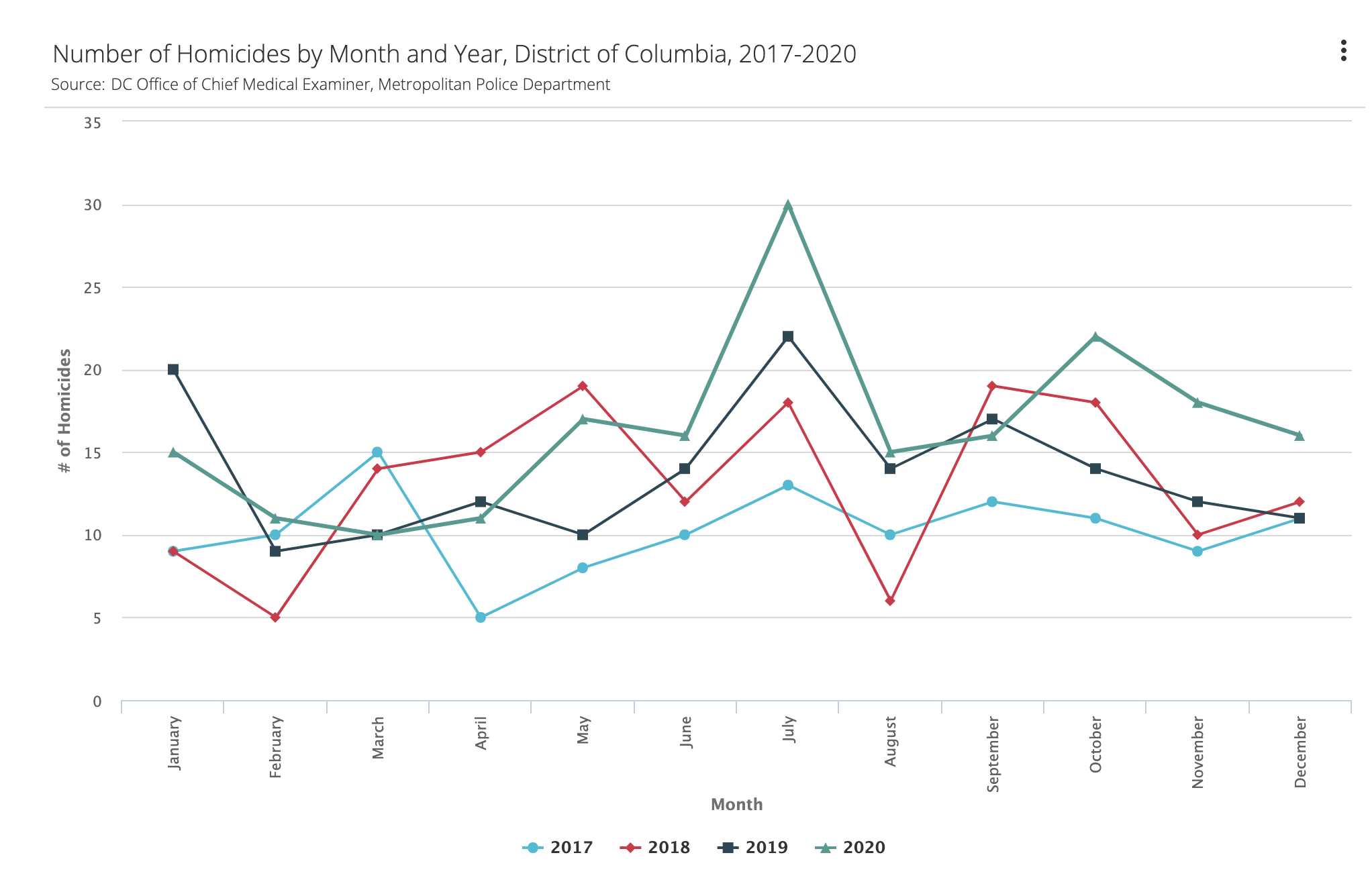
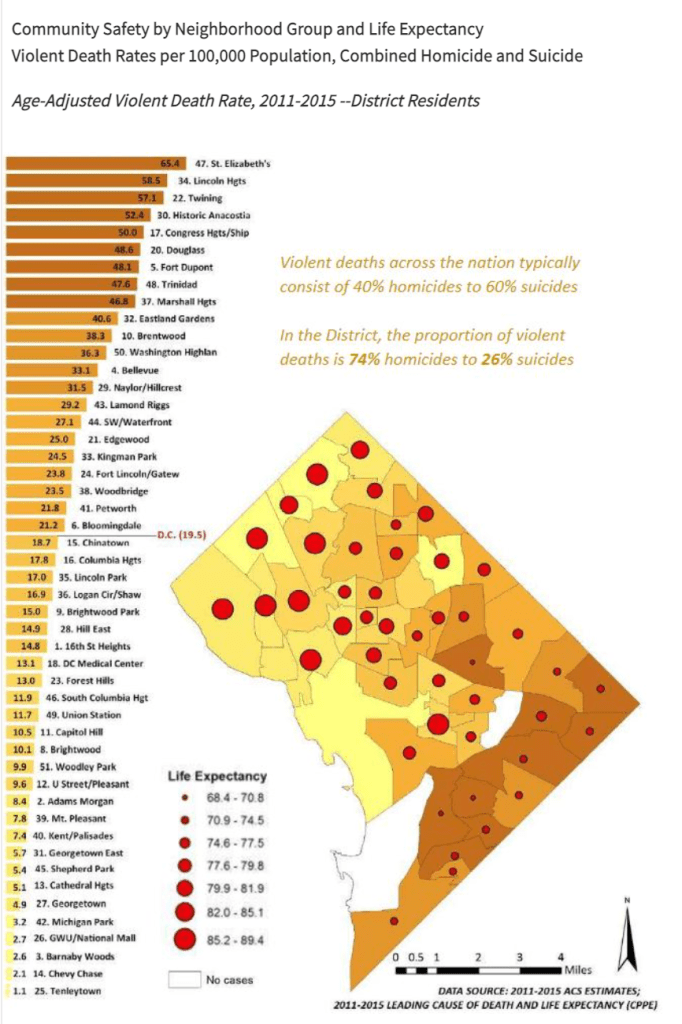 …reducing community level violence, improving community level safety is pretty critical to making sure that everyone really has access to those wellness opportunities and [are] able to take advantage of them…I mean just a different level of public safety obviously has a tremendous impact on health and well-being and so that alone, beyond access to just getting out and having recreation is just the lack of people being safe, feeling safe in their own communities…it’s a different access.
…reducing community level violence, improving community level safety is pretty critical to making sure that everyone really has access to those wellness opportunities and [are] able to take advantage of them…I mean just a different level of public safety obviously has a tremendous impact on health and well-being and so that alone, beyond access to just getting out and having recreation is just the lack of people being safe, feeling safe in their own communities…it’s a different access.
—Key Informant Interviewer

Injuries
Injuries are classified as either intentional (e.g. assault, homicide, suicide) or unintentional (e.g. poisoning, overdoses, falls, car accidents). Many injuries are predictable and preventable, yet each year nearly 30 million Americans receive medical treatment for injuries, and more than 243,000 died from these injuries in 2017 [5]. In the District, the fatal-injury rate has increased in the past decade.
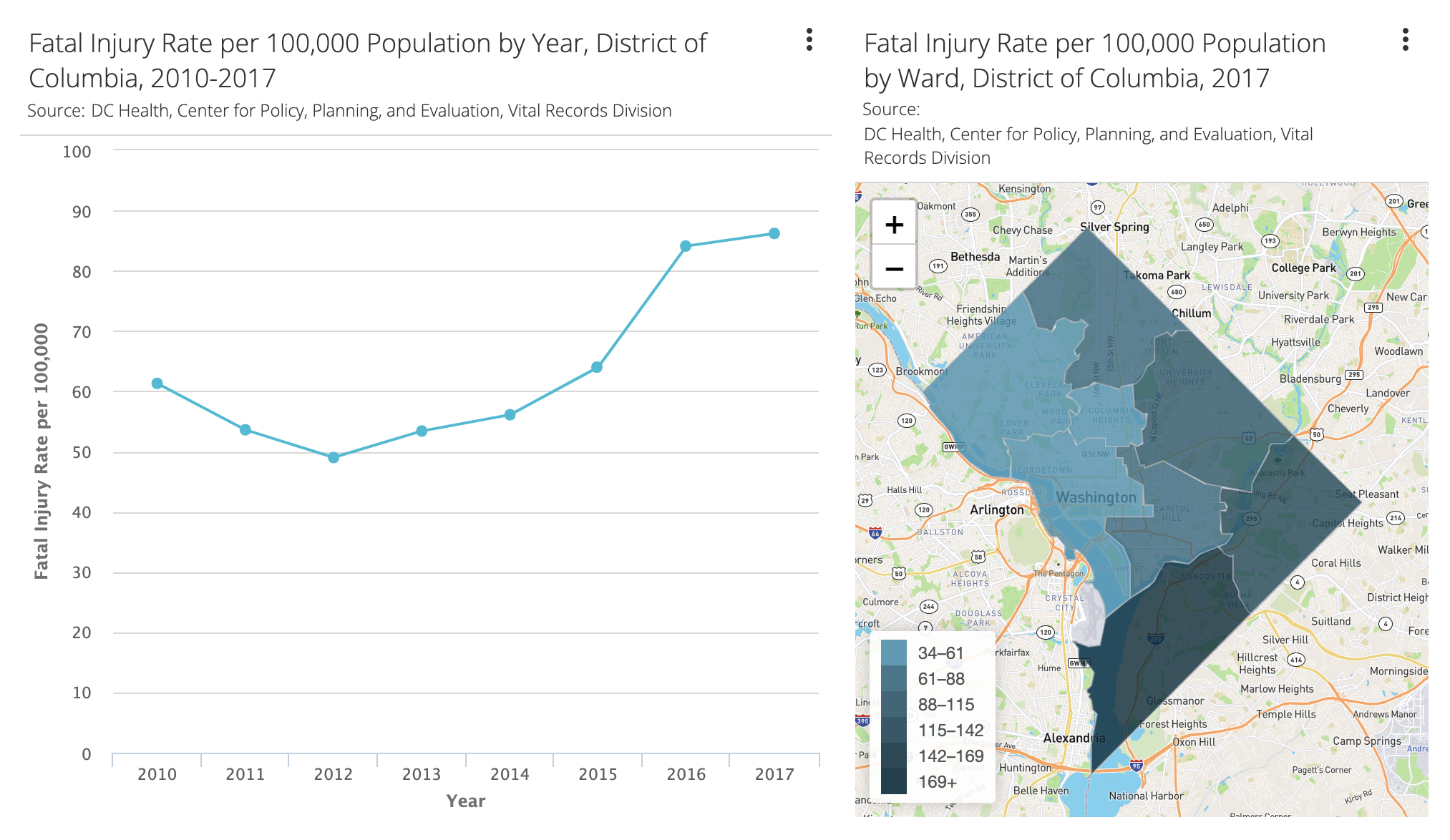
Opioids in the District
Drug overdoses have dramatically increased over the last two decades nationally, with deaths increasing by more than four times between 1999 and 2017. In 2017, there were 279 overdose deaths that involved the use of opioids in the District, however, the opioid epidemic has impacted D.C. differently than in the rest of the U.S.
Nationally, 84% deaths are to Non-Hispanic Whites, while in the District, 84% of deaths are to Non-Hispanic Blacks/African Americans [6]. Black men over 40 have been the most highly impacted population segment in the District [6].
Vision Zero
 Vision Zero is a city-wide plan to address transportation safety in the District. In 2016, DC saw 28 traffic fatalities and 12,430 traffic-related injuries [7].
Vision Zero is a city-wide plan to address transportation safety in the District. In 2016, DC saw 28 traffic fatalities and 12,430 traffic-related injuries [7].
Younger and older people, people biking, people walking, and people with disabilities are all more vulnerable to serious traffic injuries and fatalities.
Vision Zero strategies and interventions reflect different levels of reaction time and agility to allow all people to travel safely.
By the year 2024, the District aims to reach zero traffic-related fatalities and serious injuries.
Crime & Justice Systems
Involvement in the criminal justice system is deeply connected to increased risk factors stemming from the social and structural determinants of health. These connections are observed in both direct and indirect ways; criminal justice involvement and policies impact health and health affects criminal justice involvement.
For example:
• Adverse childhood experiences such as exposure to violence or the incarceration of a parent can lead to mental and behavioral health issues
• Mental health crises can lead to arrest
• Debt from health care expenses can lead to inability to pay bills, poverty, and arrest
• Experiences while incarcerated can lead to future drug use or violence
• People re-entering the community after being incarcerated face difficulty finding employment and housing
Research shows that the most effective community crime prevention programs engage a broad evidence-based community safety approach that promotes equity rather than being narrowly restricted to reducing crime [1].

In the 2019 DC CHNA Survey, 14% of respondents identified restorative justice opportunities and public health approaches to violence prevention and violence interventions as one of the most important things a community needs to reach its full potential as healthy community.
According to the District Government Office of Police Complaints, the reported use-of-force incidents by DC police officers increased by 20 percent from 2017 to 2018, which also found that the number of officers who used force increased by 18 percent over last year. More than a third of Metropolitan Police Department officers reported using force in 2018.
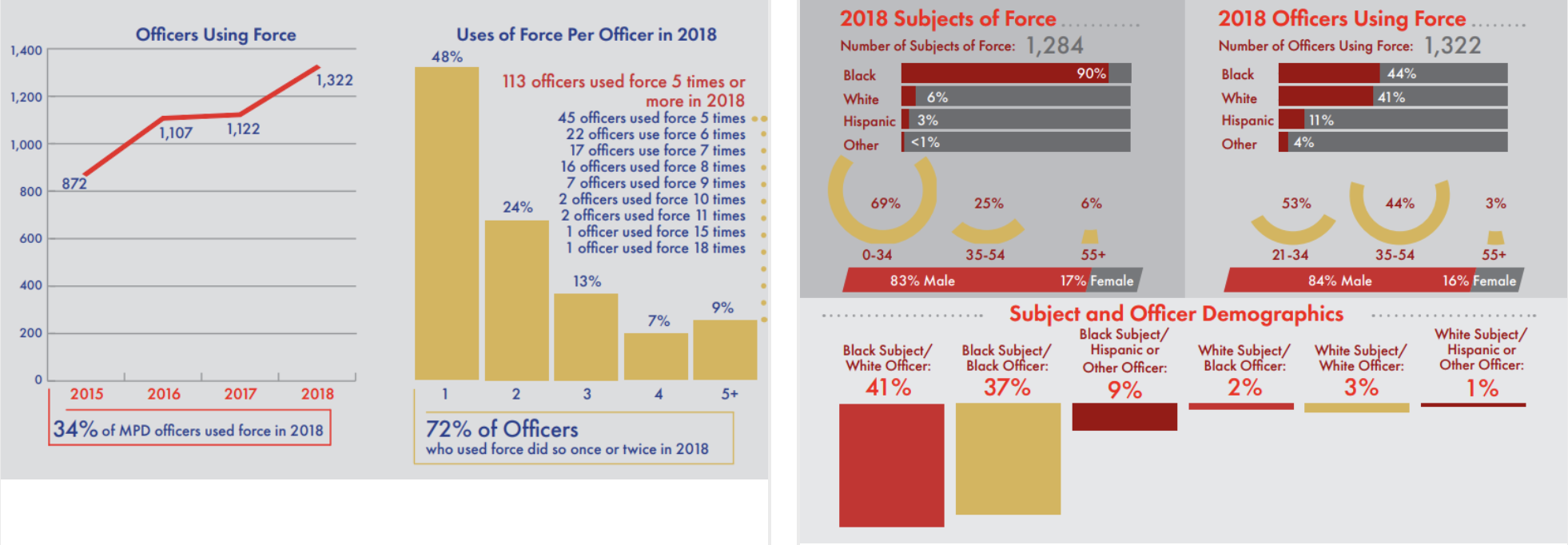
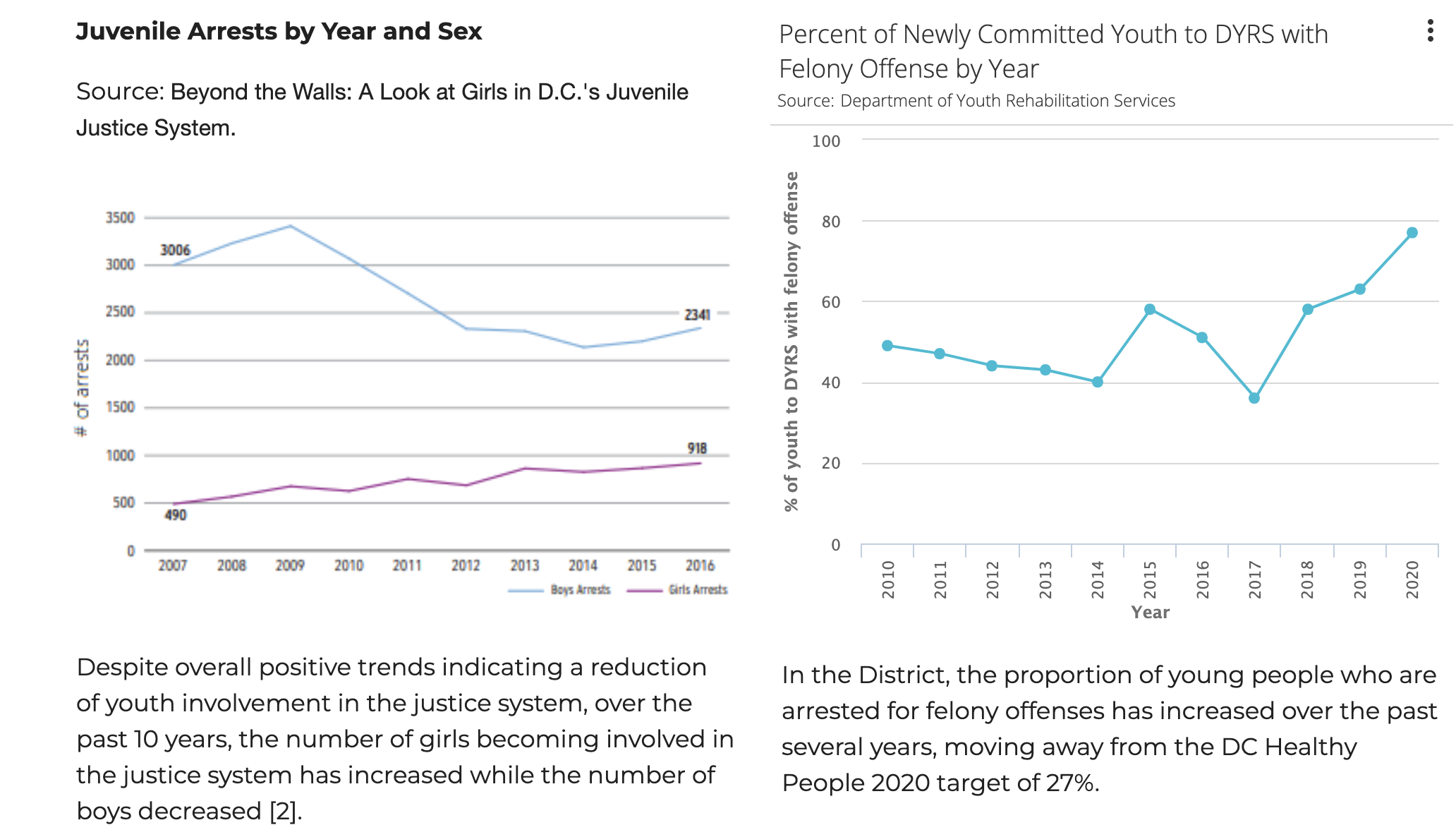
The DC Department of Corrections (DOC) operates two adult correctional facilities in the city, The Central Detention Facility for male inmates and the Correctional Treatment Facility for female inmates. The DC Detention Facility has an average daily population of 1,346 men. In 2019 the audit results from the city’s inspection described hazardous conditions including mold growth, a leaking roof, broken plumbing, and other concerns. The report concluded that without significant capital funding, the health and safety of inmates and staff were at risk [8].
The District does not operate prisons, so those convicted of felony crimes in the city serve their sentences in federal facilities across the country. In a given year, about 6,000 District residents are incarcerated in federal facilities across the country. According to the ACLU, nationwide nearly 60% of people in women’s prison, and as many as 94% of some women’s prison populations, have a history of physical or sexual abuse before being incarcerated [9].
Assets & Resources
• MPD Victim Assistance Resources
• DC YouthLink–A coalition of community-based organizations that provide a diverse array of services to court-involved youth in their neighborhoods.
• Opioid Dependency Treatment Centers, Narcan Locations, and Needle Exchange Programs
Promising Practices & Policies:
• Prioritize transportation infrastructure improvements related to bicycle and pedestrian safety using injury and crash data.
• Use YRBS data to inform school policy and decision-making and reduce disproportionate number of school suspensions by race.
• Implement restorative justice practices for individuals upon initial contact with the criminal justice system.
• Vacant property revitalization models
• Inside-Out Prison Exchange Program— A partnership between Howard University and D.C corrections brings college students and inmates together in jail to study the criminal justice system.
• Do the Write Thing-OAG
Funding Opportunities
• Cafritz Foundation, Justice: Access, Violence Prevention, Reentry Grant
• Incarceration Reduction Amendment Act (IRAA) Support Funding (RFA) Grant
• Office of Neighborhood Safety and Engagement FY 20 Planning and Implementation for a Community Crime Reduction Grant– This grant is designed to address the violence interruption needs of the Woodland Terrace and Buena Vista communities.
Citations & Additional Data Resources
1. DC Health. Health Equity Report. 2018
2. Rights4Girls and the Georgetown Juvenile Justince Initiative. Beyond the Walls: A Look at Girls in D.C.’s Juvenile Justice System. 2018
3. National Coalition Against Domestic Violence. Domestic Violence in Washington, DC. 2015
4. Metropolitan Police Department. Bias-Related Crimes (Hate Crimes Data). 2019
5. County Health Rankings. Community Safety. 2019
6. DC Health. Opioid Awareness Campaign and Education. 2019
7. DDOT. 2016 Vision Zero Progress Report. 2017
8. Office of the District of Columbia Auditor. Poor Conditions Persist at Aging D.C. Jail; New Facility Needed to Mitigate Risks. 2019
9. ACLU. Georgetown and ACLU Comment: Proposed Rule, National Standards to Prevent, Detect, and Respond to Prison Rape. 2011
Photo Credits:
“Caution Tape at the United States Capitol,” Andy Feliciotti, CC BY-Unsplash
“Bicylist–37th Annual Adams Morgan Day Festival,” Elvert Barnes, CC BY-SA 2.0



